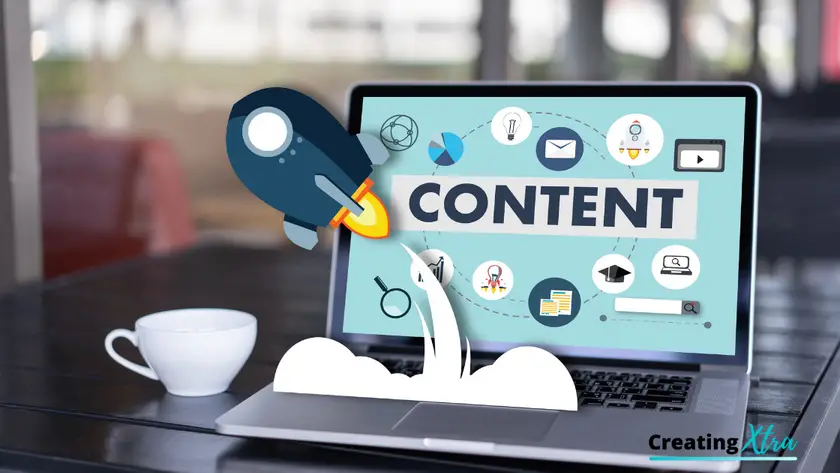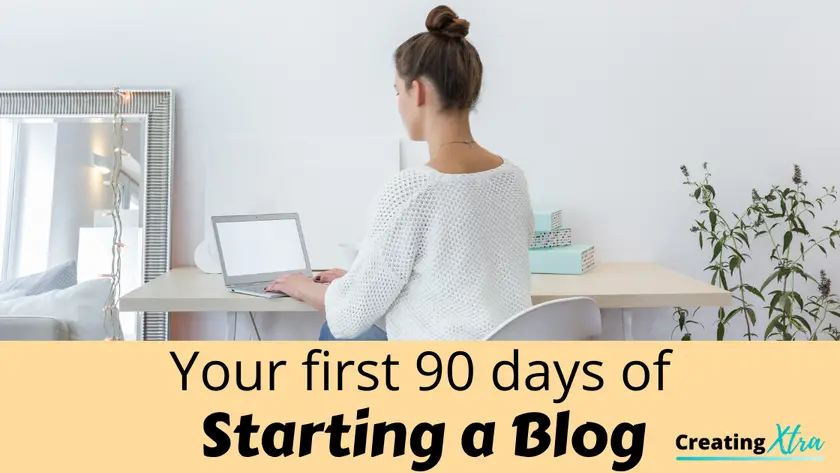You want to start a blog, but where exactly do you start?
Here I’ll take you step by step and show you what needs to be done in your blog’s first 90 days to set it up for success.
1. Think about your goals – Why start a blog?
I know you are excited to get started and want to jump right in, but here are some things you need to think about before you start a blog.
- Why do you want a blog?
- Do you want to build a side hustle?
- Do you want to go full time one day and quit your day job?
- Do you need a little extra money to pay down your debt or student loans?
- Do you want a hobby or do you want to earn a living? Both are fine, you just need to be clear on what you want to accomplish with your new blog. This will help you determine the amount of effort you want to put into your blog.
Most new bloggers start their journey on the side of a full time job, so we’ll want to spend our time on the right stuff at the right time.

When we work a full time job we don’t have the luxury of a lot of extra time to spend on our side hustle, so it’s a good idea to maximize the effective use of the time we have.
A good END GOAL:
Let’s create a profitable blog in 12 months and replace our full time income in 12 to 24 months.
GOAL FOR THE FIRST 90 DAYS
Learn as much as you can about blogging and set yourself up for success.
2. Start a website
It’s easy to get carried away with the design, colors and fonts when you start a new blog. You want to get everything just right. Nope, don’t do this, it will only slow you down. Everything can be updated or changed later.
Rather focus your efforts on the most important things:
- Get your blog set up as soon as possible
- Start creating content
BEST TIP – Perfection is NOT the key.
Start and set up a website
Here are the first steps you will need to take:
- Choose a niche (what will you blog about)
- Choose web hosting and register your domain name
- WordPress is the content management system we want to use
- Choose and install a theme
- Set up your basic pages
- Home – this is your sales page about you and what your site is about.
- About – this is your personal story page about you and why you created the blog.
- Blog – This is where your blog posts will live.
- (Other pages can always be added later)
- Set up Google Search Console and Google Analytics (to track your progress)
3. Create content
Blogging is all about creating helpful content. Things people actually go to Google or Pinterest to, to search for.
So where do you start? With keyword research. Look at what people are searching for in your niche. Look for topics with a high search volume and where the competition is not too heavy.
Creating content is the KEY to success.

types of articles to write:
Most of the posts that you are going to write should be informational posts in the beginning of your blogging journey with some transactional posts in between.
These are the types of articles that we can write:
- How to posts (This is your information articles.)
- Example: Let’s say your niche is about Gardening. How to care for roses? How much sun a certain plant needs? What soil is best for x plant?
- Best of post (This is your transactional posts / what you need)
- Example: Best compost for x plant. Best lawnmower. What garden utensils you need. Then later on you can insert affiliate links to the products you recommend and start to earn a little commission whenever someone purchases through your link.
- Ideas post
- Example: Beautiful Ideas for garden layouts
- Long lists
- Example: 10 Easy steps to create your first garden. 12 Plants that you can plant in the shade. BEST TIP – People love lists. Create lists in your article’s.
- Unique stories
- Example: Your experience in creating your own garden. What your grandparents taught you about gardening.
In your first 90 days of blogging your focus should absolutely be on creating and publishing content.
To do:
- Write down 12 blog post ideas or put it in a spread sheet
- Write 1 article a week.
You don’t have to overdo it when you start out and burn yourself out, but you should at least create and publish 1 article per week minimum.
If you want to be a blogger and get any traction with your blog, you have to at least be able to do 1 post a week.
4. On page SEO
SEO is all about getting your article’s to rank on Google and helping search engines better understand what your article is about. You can write as much as you like, but you need to get the format right to get anywhere.
Google looks for the best articles, so we need to structure our article’s in a way for Google to understand what the article is about, so it can be indexed on Google and start to rank in searches.
What is on page SEO all about?
It’s about getting the following things right: Title, URL, Headings, Semantic keywords and Internal links.
- Title
- H1 heading
- Your title must contain your article’s target keywords.
- Example: 9 Easy to grow plants for beginner gardeners
- URL
- Your url (the link to your article) must contain your article’s target keywords
- Your URL is the only thing that should never change. You can always update your article with new info, or update your heading, but never change your post’s url. You want the link to a specific article to always stay the same, for when you share the link on Pinterest or other blogs link to your article, you want the link to always work. When you make changes to the url, all those links will be broken and lost.
- Don’t use numbers in the url.
- Example: If your article’s title is, 10 Best Gardening Tools in 2022, only include best gardening tools in the url. That way if you add another item to the list or update the article the following year, you don’t have to change the numbers in the url.
- Headings in the article
- Use H2 Headings for your questions and include your target keywords.
- Use H3 Headings for your answers.
- Semantic keywords
- Let’s say your keywords for the article is about gardening for beginners, then you should include other keywords that one would associate with the same topic, like garden, landscaping, planting, plants, flowers, soil, dirt, shovel, lawn, bedding etc.
- Internal links
- As you write more and more article’s, it is a good idea to go back and insert link’s to relevant article’s that you’ve already written.
- Internal links connects your content and helps Google understand your website’s authority and how to rank your site.
- Search engines use crawlers to become familiar with different websites and internal links help lead a crawler form one page to another. It helps show it what is important content on your site.
Make sure to assemble your article the right way. Article structure is basically a science, not art. Use the formula to create the same format for every post.
5. Marketing your blog
The best ways to get your blog out there is through link building.
Getting other websites to link to your articles. To do this the legit way is to see if you can connect with other bloggers and ask them if you can write a guest blog on for their website and link to your site in the bio.
Another way to market your blog is through Pinterest.
Pinterest is still a great source of traffic and a good way to get your article’s noticed, it just takes time. Create a business Pinterest account and post pins with links to your articles. Pinterest is a search engine, so you need to consistently create pins and eventually it will start showing up in people’s feeds and search results.
It’s easy to create beautiful images for your blog posts and pins for Pinterest on Canva. It’s FREE and very user friendly. I use Canva Pro to create all my images.
I recommend using Canva Pro, it has many Pinterest templates that you can customize to create eye catching images for your pins, and you’ll have access to thousands of images, videos and vectors to use for your blog and social media.

After 90 days – blogging checklist
After your first 90 days of blogging you should have the following:
- A website with basic pages
- 12 Published blog posts
- Your first traffic in Google Analytics
You will notice that Make money is not on the 90 days checklist. Why not?
Your first 90 days we want to set the foundation for success. To make money you need traffic, to get traffic you need to rank on Google, to rank on Google your need content.
You need to focus on creating good quality content first, then after 90 days you can start adding monetization to your blog in the form of joining an ad network, placing affiliate links, creating digital products or courses. Find more info on monetizing your blog here.
A successful blog takes consistent work every week.
Set yourself up the right way, focus on the right stuff, be consistent and you will see success. It’s all up to you.

